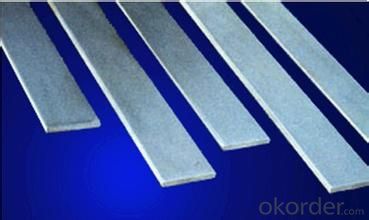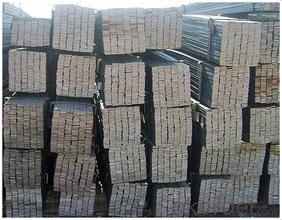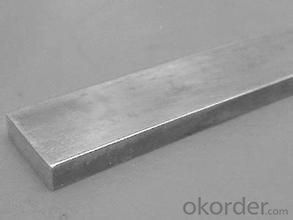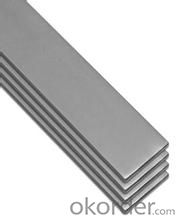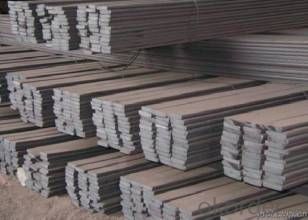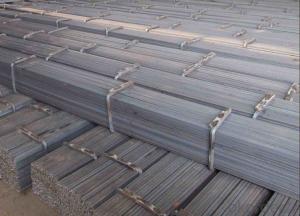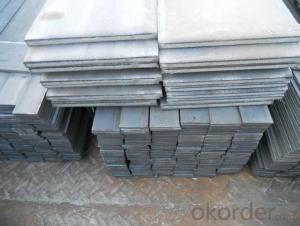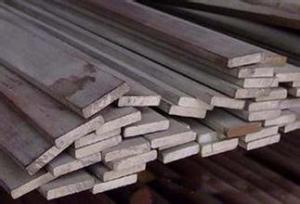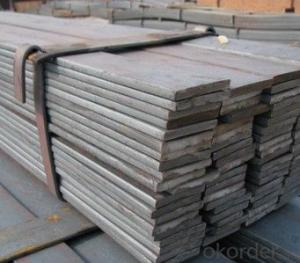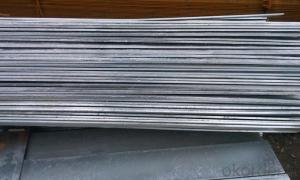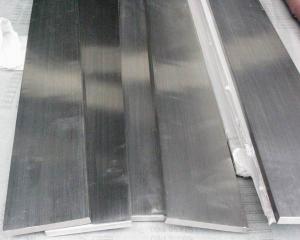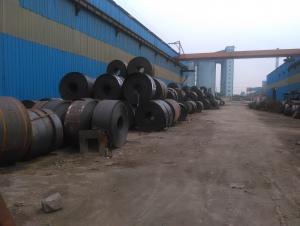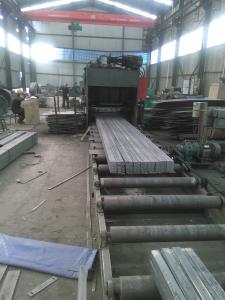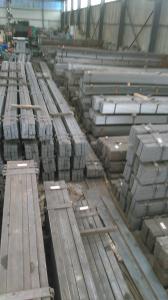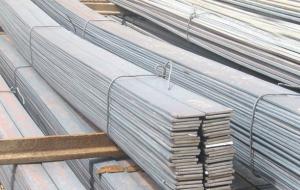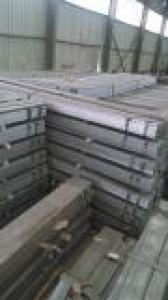Hot Rolled Wide Flat Steel 100mm*10mm*6m
- Loading Port:
- Tianjin
- Payment Terms:
- TT or LC
- Min Order Qty:
- 25 m.t.
- Supply Capability:
- 2000 m.t./month
OKorder Service Pledge
OKorder Financial Service
You Might Also Like
Product Description:
OKorder is offering Hot Rolled Wide Flat Steel 100mm*10mm*6m at great prices with worldwide shipping. Our supplier is a world-class manufacturer of steel, with our products utilized the world over. OKorder annually supplies products to European, North American and Asian markets. We provide quotations within 24 hours of receiving an inquiry and guarantee competitive prices.
Product Applications:
Hot Rolled Wide Flat Steel 100mm*10mm*6m are ideal for structural applications and are widely used in the construction of buildings and bridges, and the manufacturing, petrochemical, and transportation industries.
Product Advantages:
OKorder's Hot Rolled Wide Flat Steel 100mm*10mm*6m are durable, strong, and resist corrosion.
Main Product Features:
· Premium quality
· Prompt delivery & seaworthy packing (30 days after receiving deposit)
· Corrosion resistance
· Can be recycled and reused
· Mill test certification
· Professional Service
· Competitive pricing
Product Specifications:
Manufacture: Hot rolled
Grade: Q195 – 235
Certificates: ISO, SGS, BV, CIQ
Length: 6m – 12m, as per customer request
Packaging: Export packing, nude packing, bundled
Chinese Standard (H*W*T) | Weight (Kg/m) | 6m (pcs/ton) | Light I (H*W*T) | Weight (Kg/m) | 6m (pcs/ton) | Light II (H*W*T) | Weight (Kg/m) | 6M |
100*68*4.5 | 11.261 | 14.8 | 100*66*4.3 | 10.13 | 16.4 | 100*64*4 | 8.45 | 19.7 |
120*74*5.0 | 13.987 | 11.9 | 120*72*4.8 | 12.59 | 13.2 | 120*70*4.5 | 10.49 | 15.8 |
140*80*5.5 | 16.89 | 9.8 | 140*78*5.3 | 15.2 | 10.9 | 140*76*5 | 12.67 | 13.1 |
160*88*6 | 20.513 | 8.1 | 160*86*5.8 | 18.46 | 9 | 160*84*5.5 | 15.38 | 10.8 |
180*94*6.5 | 24.143 | 6.9 | 180*92*6.3 | 21.73 | 7.6 | 180*90*6 | 18.11 | 9.2 |
200*100*7 | 27.929 | 5.9 | 200*98*6.8 | 25.14 | 6.6 | 200*96*6.5 | 20.95 | 7.9 |
220*110*7.5 | 33.07 | 5 | 220*108*7.3 | 29.76 | 5.6 | 220*106*7 | 24.8 | 6.7 |
250*116*8 | 38.105 | 4.3 | 250*114*7.8 | 34.29 | 4.8 | 250*112*7.5 | 28.58 | 5.8 |
280*122*8.5 | 43.492 | 3.8 | 280*120*8.2 | 39.14 | 4.2 | 280*120*8 | 36.97 | 4.5 |
300*126*9 | 48.084 | 3.4 | 300*124*9.2 | 43.28 | 3.8 | 300*124*8.5 | 40.87 | 4 |
320*130*9.5 | 52.717 | 3.1 | 320*127*9.2 | 48.5 | 3.4 | |||
360*136*10 | 60.037 | 2.7 | 360*132*9.5 | 55.23 | 3 |
FAQ:
Q1: Why buy Materials & Equipment from OKorder.com?
A1: All products offered byOKorder.com are carefully selected from China's most reliable manufacturing enterprises. Through its ISO certifications, OKorder.com adheres to the highest standards and a commitment to supply chain safety and customer satisfaction.
Q2: How do we guarantee the quality of our products?
A2: We have established an advanced quality management system which conducts strict quality tests at every step, from raw materials to the final product. At the same time, we provide extensive follow-up service assurances as required.
Q3: How soon can we receive the product after purchase?
A3: Within three days of placing an order, we will begin production. The specific shipping date is dependent upon international and government factors, but is typically 7 to 10 workdays.
Q4: What makes stainless steel stainless?
A4: Stainless steel must contain at least 10.5 % chromium. It is this element that reacts with the oxygen in the air to form a complex chrome-oxide surface layer that is invisible but strong enough to prevent further oxygen from "staining" (rusting) the surface. Higher levels of chromium and the addition of other alloying elements such as nickel and molybdenum enhance this surface layer and improve the corrosion resistance of the stainless material.
Q5: Can stainless steel rust?
A5: Stainless does not "rust" as you think of regular steel rusting with a red oxide on the surface that flakes off. If you see red rust it is probably due to some iron particles that have contaminated the surface of the stainless steel and it is these iron particles that are rusting. Look at the source of the rusting and see if you can remove it from the surface.
Images:
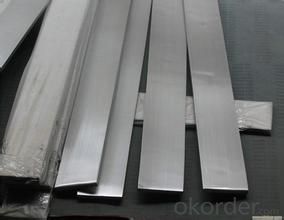
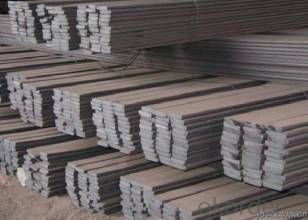
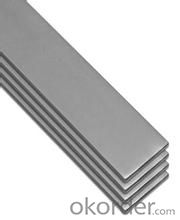
- Q: Are steel flat bars suitable for making brackets or supports for fire protection systems?
- Indeed, steel flat bars possess the appropriate qualities to serve as brackets or supports for fire protection systems. Renowned for its robustness and longevity, steel stands as a dependable substance for fashioning such components. The demands of fire protection systems often necessitate the presence of resilient and heat-resistant elements, prerequisites that steel flat bars fulfill. These bars can be effortlessly molded and joined through welding techniques to produce tailor-made brackets or supports capable of enduring the burdensome loads and strains involved in fire protection systems. Moreover, steel's non-combustible nature and elevated melting point amplify its appropriateness for fire protection purposes.
- Q: How do steel flat bars compare to other forms of steel like angles or channels?
- Steel flat bars, angles, and channels are all versatile and commonly used forms of steel. However, they differ in terms of their structural characteristics and applications. Steel flat bars are typically rectangular in shape with a flat surface, making them ideal for structural support, framing, and industrial applications where a flat surface is required. On the other hand, steel angles have an L-shaped cross-section, providing superior strength and stability, making them suitable for construction projects, bracing, and framework. Steel channels, with a U-shaped cross-section, offer excellent load-bearing capabilities, making them popular for applications such as beams, supports, and vehicle frames. Ultimately, the choice between these forms of steel depends on the specific requirements of the project at hand.
- Q: What is the weight of a steel flat bar?
- The weight of a steel flat bar can vary depending on its dimensions and specific type of steel.
- Q: How do you prevent rusting on steel flat bars?
- To avoid rusting on steel flat bars, there are several actions you can take: 1. Keep the bars dry: Moisture plays a significant role in rust formation. Ensure that the flat bars are stored in a dry environment and avoid exposing them to water or excessive humidity. 2. Apply a protective coating: Applying a protective coating is an effective method to prevent rust. Options include paint, varnish, or a specialized rust-resistant coating. It is important to select a coating specifically designed for steel and capable of withstanding the intended use of the flat bars. 3. Opt for galvanized steel: Galvanization involves coating steel with a layer of zinc. This protective layer acts as a barrier against moisture and prevents rust. Galvanized steel flat bars are highly resistant to corrosion and can be an excellent choice for rust prevention. 4. Ensure proper ventilation: In environments with high humidity or exposure to chemicals, adequate ventilation is crucial. Proper airflow helps prevent the accumulation of moisture, reducing the risk of rust formation. 5. Regularly clean and inspect: It is essential to regularly clean the steel flat bars and inspect them for any signs of rust or damage. If any rust spots are detected, prompt action should be taken to prevent further corrosion. 6. Store the bars correctly: When storing steel flat bars, ensure they are kept in a dry location, away from potential sources of moisture. Consider using storage racks or shelves to prevent direct contact with the ground or other surfaces that may accumulate moisture. By following these preventive measures, the chances of rusting on steel flat bars can be significantly reduced, prolonging their lifespan.
- Q: Can steel flat bars be used in electrical applications?
- Yes, steel flat bars can be used in electrical applications. Steel is a highly conductive material and can effectively carry electrical current. Flat bars made of steel are often used as grounding conductors, busbars, and connectors in electrical systems. They are commonly used in switchgear, panel boards, control panels, and other electrical equipment. However, it is important to ensure that the steel flat bars used in electrical applications meet the necessary electrical and safety standards to prevent any potential hazards.
- Q: How to determine the application direction of steel grid plate
- The width of the groove generally refers to the length of the steel grid (including the required width of the groove), and the width of the steel plate along the longitudinal direction of the groove
- Q: Can steel flat bars be used for making tools or machinery parts?
- Making tools or machinery parts is possible using steel flat bars. Steel is a widely used and adaptable material in the manufacturing industry because of its strength, durability, and resistance to wear and tear. Steel flat bars are easy to shape, cut, and manipulate into desired tool or machinery parts, which makes them popular for different purposes. They can be utilized in constructing frames, supports, brackets, and other structural components in machinery or tools. Moreover, steel flat bars can undergo heat treatment or surface treatments to enhance their properties and optimize their performance in specific applications. In summary, steel flat bars are a dependable and effective choice for creating tools or machinery parts due to their strength, versatility, and compatibility with various manufacturing processes.
- Q: Are steel flat bars suitable for high-temperature environments?
- When it comes to high-temperature environments, steel flat bars are generally a good choice. However, the type of steel and its maximum temperature tolerance will vary depending on the specific use. For instance, stainless steel flat bars are particularly known for their excellent resistance to heat and can withstand temperatures as high as 1500°F (816°C). They also have good mechanical properties, which means they can maintain their strength and shape even when exposed to high temperatures. Nevertheless, it is important to consider the unique requirements of each high-temperature environment. Factors such as the duration of exposure to high temperatures, the presence of corrosive substances, and the potential for thermal expansion or contraction must be taken into account. In some extreme situations, such as in furnaces, specialized high-temperature alloys or refractory metals may be more suitable. To ensure the best performance in a specific high-temperature application, it is always recommended to seek the advice of a materials engineer or specialist. They can assess the specific requirements and offer guidance on the most appropriate steel grade, heat treatment, and any additional protective measures that may be necessary.
- Q: Can steel flat bars be used for making storage systems?
- Indeed, storage systems can be fashioned using steel flat bars. Due to its durability and strength, steel proves to be an appropriate material for fabricating storage systems capable of enduring substantial weights and offering structural reinforcement. Steel flat bars present an opportunity to construct shelves, racks, and frames to accommodate storage systems found in warehouses, retail establishments, or even residential or office spaces. Moreover, steel flat bars can be effortlessly welded, cut, and molded according to precise design prerequisites, rendering them versatile in crafting tailor-made storage resolutions.
- Q: What are the common methods of surface finishing for steel flat bars?
- Steel flat bars can be surface finished through several common methods. These techniques aim to improve the steel's appearance, corrosion resistance, and durability. Hot-dip galvanizing is a prevalent method. It involves immersing the steel flat bars in a bath of molten zinc, resulting in a protective coating that prevents rust and oxidation. Electroplating is another technique, whereby a thin layer of metal, such as chromium, nickel, or zinc, is deposited onto the steel's surface. This not only enhances the appearance but also offers protection against corrosion. Powder coating is a popular choice as well. It entails applying a dry powder electrostatically to the steel's surface, which is then cured under heat to create a durable and visually appealing coating. Powder coating provides excellent resistance against corrosion, abrasion, and chemicals. Shot blasting is a mechanical process used to clean and prepare the steel flat bars' surface. It involves blasting small steel shots at high speed, effectively removing rust, scale, and contaminants. This leaves the surface clean, smooth, and ready for subsequent finishing processes like painting or coating. Painting is also commonly employed. Different types of paints, such as epoxy, polyurethane, or enamel, can be applied to the steel's surface. This not only adds corrosion protection but also enhances the appearance. In conclusion, these surface finishing methods for steel flat bars offer various advantages, including corrosion resistance, improved appearance, and enhanced durability. The choice of method depends on the specific requirements and conditions in which the steel flat bars will be utilized.
Send your message to us
Hot Rolled Wide Flat Steel 100mm*10mm*6m
- Loading Port:
- Tianjin
- Payment Terms:
- TT or LC
- Min Order Qty:
- 25 m.t.
- Supply Capability:
- 2000 m.t./month
OKorder Service Pledge
OKorder Financial Service
Similar products
Hot products
Hot Searches
Related keywords





